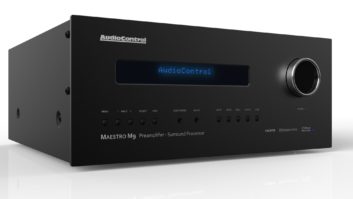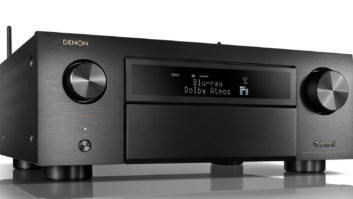On December 4, Residential Systems presented a webinar about the new IMAX Enhanced program that was hosted by John Sciacca and featured a panel of in-the-know professionals (see “Who’s Who” below for bios). A lot of ground was covered over the hour-long session and, while we don’t have the space to include the full transcript, we present some highlights here. (The full webinar is available for free on demand. Click here to access it.)
Who’s Who
HOST: John Sciacca, Custom Theater and Audio
John Sciacca is a principal with Custom Theater and Audio, in Myrtle Beach, South Carolina. In his free time, he writes reviews and blogs prolifically about the CE industry for Residential Systems.Rob Brennan, Training Manager, Home Entertainment and Sound, Sony Electronics Inc.
As the Home entertainment and sound technology and training manager at Sony North America, Rob Brennan communicates the Sony brand story, product features, and benefits, as well as fundamental technologies to a wide audience that includes industry partners, press, and enthusiasts. With more than 15 years’ experience working in the fields of training and communication, Brennan played a significant role in the launch of many of Sony’s premier products, including 4K, HDR, OLED, and, most recently, the Master Series line of ultra-premium TVs.Phillip Jones, Director of Training, Sound United
Philip Jones is the director of training at Sound United. He is responsible for developing training content and sales tools to support the multiple Sound United brands throughout North America. He works directly with the engineering and marketing teams to create training materials and retail tools to effectively highlight the benefits of Sound United’s product lineup. Philip’s goal is to provide internal employees, retailers, and members of the press with information and assets to best relay the features and benefits of Sound United brands to people.Bruce Markoe, Senior Vice President, Head of Postproduction, DMR and Operations, IMAX Corporation
Bruce Markoe oversees IMAX’s production and postproduction efforts along with the Camera group, DMR, and Operations teams, and works closely with today’s biggest filmmakers to optimize their films for IMAX presentation. With a career in film postproduction spanning decades, Markoe has worked in all aspects of feature production and postproduction, including visual effects, sound, editorial, developing digital workflows, and managing operations at Marvel Studios, Overture Films, Revolution Studios, and MGM studios, among others. He is a member of the Motion Picture Academy of Arts and Sciences.John McDaniel, Vice President, Business Development – Ecosystems, Xperi Corporation
John McDaniel is vice president, business development responsible for ecosystem opportunities at Xperi Corporation. With nearly 14 years serving in engineering, product management, and strategic roles, John has launched many DTS audio technology solutions on both the content and device sides of the business.
John Sciacca: What exactly is IMAX Enhanced?
Bruce Markoe: As most people know, IMAX theater screens are bigger on average than anybody else’s in the industry, and we have our own proprietary projection technology that is brighter and features higher contrast than any other system on the market. We also have a proprietary theater sound format that has more amplification, more robust speakers, and a slightly different speaker configuration than other theaters.
Because of this unique design, we have to remaster movies specifically for IMAX theaters. This was done and developed with a new tool called DMR (Digital Media Remastering), which is basically a noise reduction tool that helps us optimize the movies to our screens. This is done in conjunction with the original filmmakers to really optimize the way the movie looks and sounds.
And now, because high dynamic range displays have become more common and much larger in size, much brighter, and with much higher contrast, it sounds like what our theaters have had for quite some time. And one of the issues that we’ve noticed is that, on high dynamic range displays, noise — especially in films — has become a huge problem. It wasn’t really noticeable before in other video formats and standard HD.
So our new version of DMR technology is really good at reducing the kind of grain and noise in the imagery and managing it in a way where the filmmakers have control over it to really adjust the way the movie looks in the home on a high dynamic range, bright display. That’s what led us into creating IMAX Enhanced, which is an ecosystem of products and content that is optimized for HDR 4K large screen TVs.

John Sciacca: What can you tell us about the first models that will be available from Sony and Sound United?
Rob Brennan: In terms of the products that Sony has that are already IMAX Enhanced certified, we have a few products in both our television lineup as well as our consumer display projector products. We recently launched our new Master Series line of televisions that includes both an OLED and an LCD flat panel television. Both of these are IMAX Enhanced certified, as well as our X900F television, which is also LCD based. Those are all available right now at retail through regional accounts and online and big box retailers.
As far as our projector line, all of the current Sony true 4K projectors support IMAX Enhanced, and that starts with our VPL-VW295ES that retails for about $5000 all the way up to our flagship 5000-lumen 4K laser projector, the VPL-VW5000ES, that retails for $60,000.
Although they are end of life, if you happen to have either of our last year’s 4k models, including the 285 or 385,those support IMAX Enhanced as well.
Phillip Jones: Both of our AVR brands, Denon and Marantz, have launched products that support IMAX Enhanced. I did put together a quick little slide of the Denon models and the Marantz models [see figure 1]. Both of our high-end Marantz flagship AV processors, the AV7705 and AV8805, also support IMAX Enhanced as well. Basically, if you’re in that $1599 to $1699 price point, you’re right where we start offering you the performance that IMAX Enhanced offers.

John Sciacca: What benefits will a user expect from IMAX enhanced certified products.
Phillip Jones: Just as Sony is concerned with reproducing the artist’s intent, so is Sound United. We’re an audio company. All of our brands are audio brands. What the artist created is what we want to deliver, and we want to give the consumer options. If you go to a movie theater to see a blockbuster movie right now, you’ll see there will be a Dolby Vision Atmos theater, an IMAX theater, a 3D IMAX theater, a standard theater, and maybe even a THX theater all showing that same movie. It’s not for us as a manufacturer to determine what is the best format for the consumer or for the client. It is that person’s decision, and we want to make sure that, regardless of what movie or what way they want to watch the movie, they get the best performance and what the director and what the creator intended.
John Sciacca: According to IMAX’s statement, “Manufacturers must design home theater equipment to meet a carefully prescribed set of the highest audio and video performance standards set by a certification committee of IMAX and DTS engineers and Hollywood’s leading technical specialists.” Can you comment on what these performance standards are?
John McDaniel: It is related to the AVR’s capability — the processor’s capability — to reproduce that IMAX signature sound. So obviously there are some requirements in terms of the amplifiers and the general speaker layout capabilities of the device itself on the AVR side. DTS:X is a minimum requirement for immersive audio, and there are certain requirements around reproduction of that IMAX signature sound on the bass management and LFE side as well. And then on the display and the projector side there are minimum requirements around luminance and black level.
In a rush? 6 Things We Learned at the “IMAX Enhanced Investigated” Webinar
John Sciacca: What will be the ideal home speaker layout for IMAX Enhanced, and what is the maximum number of channels that it can support?
Phillip Jones: It should be 7.1.4, which is an 11.1-channel format, which many of the AVRs support. A lot of times people are doing something like a 9.1.4 setup, and then when it sees the IMAX Enhanced or DTS:X content it switches to using the 7.1.4 configuration.
John Sciacca: What version of HDR will the Enhanced titles be using? Will it be HDR10, 10+, or Dolby Vision?
Bruce Markoe: It won’t be on Dolby Vision titles, but will be on HDR10 or HDR10+, and that’s basically determined by the studios.
Phillip Jones: One thing I want to stress is that 10+ is backwards compatible with HDR10, so even if the disk has HDR10+ on it, you can still play it back in HDR10 if the display doesn’t support 10+. I believe the IMAX disc that I have has 10+ on it, and my TV is not a 10+ and it plays fine.
John Sciacca: Is there a minimum screen size that would be considered, or is it more to do with the display’s capabilities and video parameters?
John McDaniel: In general, 65 inches and above. We’re trying to reproduce that IMAX cinema experience in the home, and we feel that those larger displays are a better reproduction of that experience.
Related: First IMAX Enhanced Disc Reviewed
John Sciacca: So when can we expect this new certified IMAX content to start being available?
John McDaniel: The initial titles, Journey to the South Pacific and The Beautiful Planet, were released December 11, and our content partners will make additional announcements shortly.


John Sciacca: How will we expect the content to be primarily delivered? Will it be only on disc or will there be any streaming content?
Bruce Markoe: How the studios choose to distribute the content is pretty much up to them. Some are going to favor physical media; others are going to favor streaming, but there will be streaming platforms available. And my guess is that streaming may become the preferred method, as it seems to be going in that direction, but there’ll be both physical media and streaming content.
John Sciacca: We are getting attendee questions on speaker placement. What is recommended?
Phillip Jones: The speaker setup is the same as the recommended DTS:X speaker setup. We can also do the same type of setup for Dolby Atmos, so if you understand how to set up a speaker system to optimize a DTS:X setup, do that. Once you do that, you’ll get great DTS:X and then the second that IMAX Enhanced signal is detected, the AVR will make the bass management and the other adjustments required to utilize that speaker layout properly. You don’t have to know a new speaker layout.
If you have an 11-channel system, that’s four heights and up to seven surround speakers (7.1.4) or, if you have one of our 13-channel receivers, you can have a 7.1.6 setup with front heights, mid heights, and rear heights, and, when the DTS:X turns on, it’s going to switch off the middle height speakers.
It’s the same setups you’re doing now.
That’s all the space we have here, but click here to experience the full “IMAX Enhanced Investigated” webinar.






